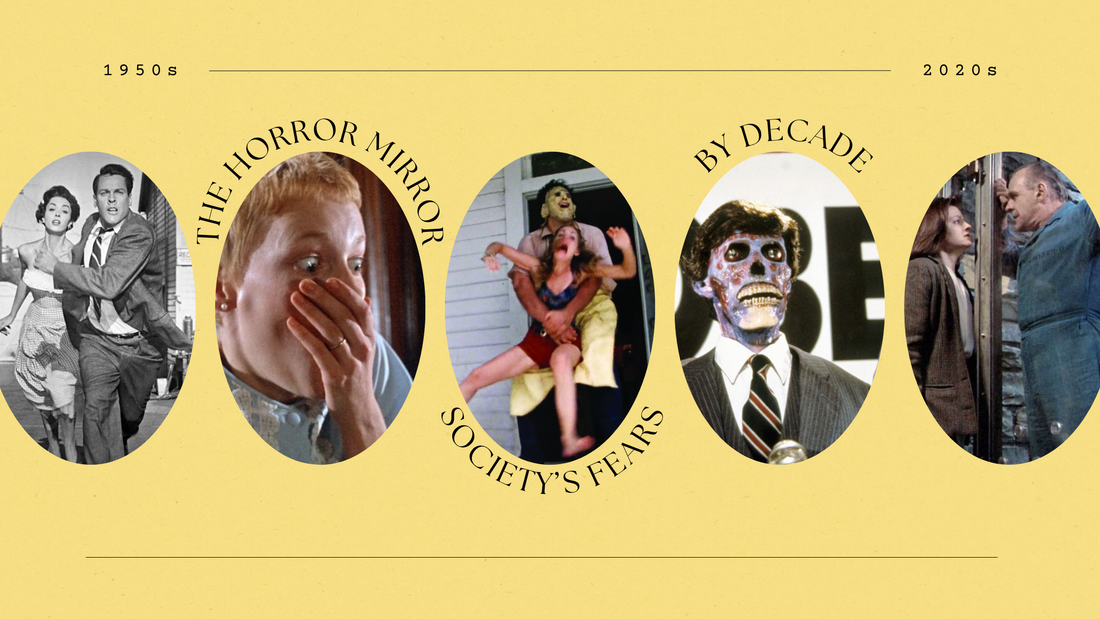Horror isn’t just the face value of monsters, gore, or jump-scares—when at its best, it’s a visceral reflection of what our society fears. The most rich horror films don’t merely entertain - they hold up a mirror to our anxieties, moral panics, historical traumas, and shifting cultural fault lines.
Below is a decade-by-decade analysis of how horror cinema has projected societal fears onto the screen.

1950s – Atomic Age & Red Scare: Monster as Manifested Fear
In the aftermath of WWII and the advent of nuclear weapons, the 1950s were haunted by the possibility of mass annihilation, radiation, and unseen enemies. American fears of communist infiltration (McCarthyism) merged in films like Invasion of the Body Snatchers (1956) and unstoppable destruction in Godzilla (1954).
The monster here often embodied contamination—of bodies, ideologies, nations. The threat was not just visible; it was intangible: radiation, alien infiltration, bodily takeover. Horror allowed audiences to externalize these anxieties, offering a cathartic way to view the invisible threats of the decade.

1960s – Social Upheaval & the Body as Battleground
The 1960s saw civil rights movements, the sexual revolution, and escalating distrust of institutions. Horror shifted accordingly. Films like Psycho (1960) and Rosemary's Baby (1968) pivoted toward psychological terror and transformation.
Emerging conceptions of identity, gender, and autonomy clashed with traditional norms of the time. For example, Rosemary's Baby has been interpreted as reflecting male anxieties about female power and autonomy. The monstrous is not external here—it is internal, intimate, shape-shifting. What appears harmless on the surface is plotting underneath.

1970s – Urban Decay, Cults & Internal Threats
Moving into the 1970s, the societal mood darkened once more: Watergate, Vietnam, urban crises, cult scandals. Horror responded with films that broke down the barrier between “safe” and “threatening.” The monster wasn’t stuck in the sky or lab; it could be in the home, the neighborhood, or the seemingly average community. The rise of films like The Texas Chain Saw Massacre (1974) reflects this shift.
Sensational fear dipped deeper into everyday life: families turned cannibalistic, trust collapsed, communities unraveled and were left barren. Horror mirrored the notion that behind the veneer of normality lurked chaos—and that no place was immune.

1980s – Consumerism, Media Saturation & the Rise of the Serial Killer
The 80s brought economic shifts, materialism, cable television, and the emergence of the “serial killer” news cycle. Horror films responded with slashers like A Nightmare on Elm Street (1984) and political critiques like They Live (1988)—movies that blended spectacle with satire, and turned suburban life into a hunting ground.
The fear was getting more layered: technology that controls us, media that lies to us, home as the site of terror, and the anonymized killer among us. The monster was no longer monstrous in the traditional boogeyman sense—it could blend in, invade, and mimic everyday life.

1990s – Technophobia, Identity Anxiety & the End of Innocence
With the Cold War ending, attention shifted to new fears: technology's rise, unseen viruses, fractured identity. Horror started to become more introspective and cerebral: The Silence of the Lambs (1991) and Se7en (1995) focused on moral decay, voyeurism, and the notion again that evil hides in plain sight.
The era’s anxiety hovered around information overload, the dissolution of clear identity, and the dangers of unseen systems. Horror responded by charting the abyss within, and how it could effect those around it with an unchecked display of power and violence.

2000s – Terror, Surveillance & the Home Invasion Turn
The early 21st century was shaped by 9/11, the war on terror, climate anxiety, and digital surveillance. Horror mirrored this sense of vulnerability: films like 28 Days Later (2002) explored contagion and breakdown, while The Strangers (2008) portrayed threat within the supposedly safe home.
The fear the horror film depicts is no longer far-away—it’s internal, ambient, and ubiquitous. The home, the neighborhood, the network—they’re all suspect.

2010s–Present – Identity, Community Collapse & Virtual Horror
In the current decade, horror shifts yet again to reflect ecological dread, social fragmentation, algorithmic control, and mediated terror. Films such as Get Out (2017), Us (2019), and The Invisible Man (2020) engage explicitly with race, gender, class, and technology.
Here the monster might be a system as much as a being: capitalism as vampire, social media as trap, climate collapse as monster. Horror becomes the ontology of anxiety—what we fear now is not just a creature, but ourselves, our neighbors, and the systems we rely on and unfortunately trapped ourselves into.
Final Thoughts
From mushroom clouds to haunted houses, from slashers in suburbia to AI horror in our devices—the evolution of horror cinema is a perfect lens to view societal changes. Each decade’s fears—deep, diverse, often unspoken—found manifestation in monsters, ghosts, and more.
By studying the horror film canon alongside our own cultural history, we can trace not just what scared us, but why it got under our skin so precisely. And in doing so, we see horror not only as cathartic escapism, but as a kind of social barometer—a dark mirror held up to the collective psyche.
